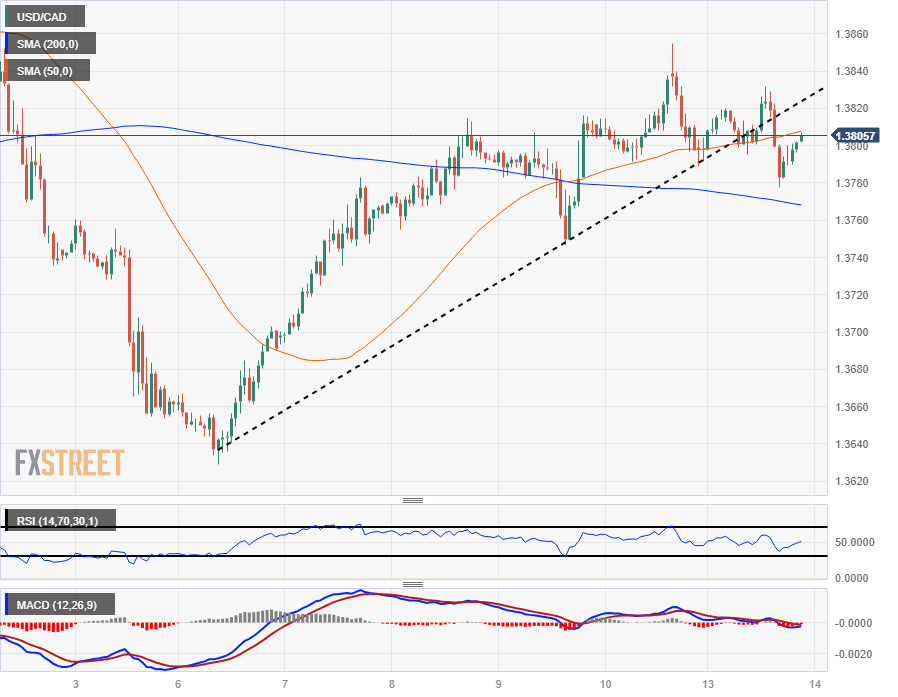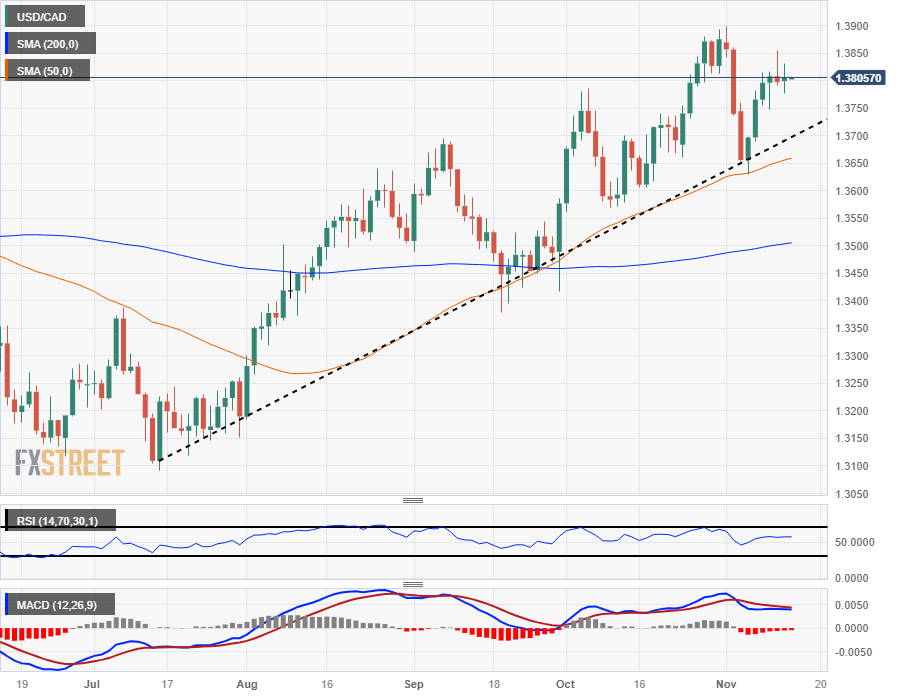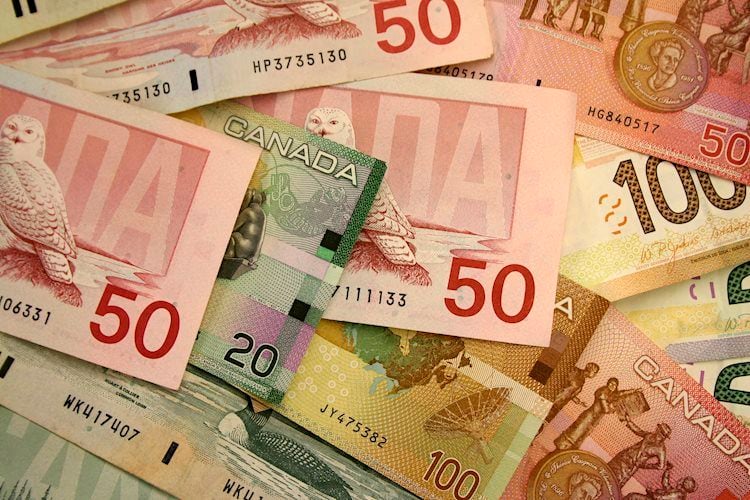- The Canadian Dollar is adrift on a thin market at the start of the trading week.
- Canada’s Remembrance Day holiday has most provinces out of the office for Monday.
- The economic calendar is sparse this week, little Canadian data on offer.
The Canadian Dollar (CAD) is finding little momentum in thin holiday markets, with the majority of Canadian provinces and territories taking the day off in observance of Remembrance Day.
There’s little of note on the economic data docket for the CAD this week, and the Loonie will be at the whim of overall market sentiment as the trading week unwinds.
Daily Digest Market Movers: Canadian Dollar shifting around a base of thin bids for Monday
- Monday momentum is limited, capping momentum in either direction to kick off the early trading week.
- There is a notable lack of viable economic data on offer for CAD traders this week.
- Loonie to trade according to market flows with a hefty US data schedule slated for this week.
- Early Tuesday will see Bank of Canada (BoC) Deputy Governor Toni Gravelle deliver talking points while participating in a panel discussion labeled ”Challenges for Financial Stability and Financial Regulation amid Heightened Uncertainty”.
- BoC Dep Gov Gravelle is participating in the Third High-Level Conference on Global Risk, Uncertainty, and Volatility, in Zurich, Switzerland.
- The BoC’s Council Member is not expected to move markets much, but investors will want to keep an eye out.
Technical Analysis: Canadian Dollar sees thin action for Monday, US Dollar in the driver’s seat
The CAD is seeing thin markets on Monday as it trades against the US Dollar (USD), and shifting sand beneath the Greenback is sending the USD/CAD pair down below the 1.3800 handle for Monday. Thin markets are set to keep the Loonie-Dollar pair constrained for the early part of the week’s trading session.
The USD/CAD is struggling to maintain bullish momentum following last week’s rebound from the 50-day Simple Moving Average (SMA) near 1.3630. A continuation of downside moves will see last Friday’s rejection from 1.3850 firm up into a technical ceiling below November’s early high bids near 1.3900.
On the downside, a bearish extension will see challenges from the 200-day SMA currently pushing upward through 1.3500. A lack of recent directional momentum is seeing technical indicators begin to drift toward the middle, with the Relative Strength Index (RSI) currently heading into the 50.0 median barrier.
USD/CAD Hourly Chart

USD/CAD Daily Chart

Canadian Dollar price this week
The table below shows the percentage change of Canadian Dollar (CAD) against listed major currencies this week. Canadian Dollar was the strongest against the New Zealand Dollar.
| USD | EUR | GBP | CAD | AUD | JPY | NZD | CHF | |
| USD | -0.09% | -0.42% | 0.04% | -0.23% | 0.14% | 0.23% | -0.05% | |
| EUR | 0.09% | -0.33% | 0.14% | -0.13% | 0.22% | 0.32% | 0.03% | |
| GBP | 0.41% | 0.33% | 0.46% | 0.19% | 0.55% | 0.66% | 0.36% | |
| CAD | -0.05% | -0.13% | -0.46% | -0.28% | 0.09% | 0.19% | -0.10% | |
| AUD | 0.23% | 0.13% | -0.18% | 0.26% | 0.35% | 0.47% | 0.18% | |
| JPY | -0.14% | -0.23% | -0.55% | -0.10% | -0.37% | 0.11% | -0.19% | |
| NZD | -0.23% | -0.33% | -0.66% | -0.20% | -0.47% | -0.11% | -0.30% | |
| CHF | 0.05% | -0.03% | -0.36% | 0.10% | -0.16% | 0.19% | 0.29% |
The heat map shows percentage changes of major currencies against each other. The base currency is picked from the left column, while the quote currency is picked from the top row. For example, if you pick the Euro from the left column and move along the horizontal line to the Japanese Yen, the percentage change displayed in the box will represent EUR (base)/JPY (quote).
Central banks FAQs
Central Banks have a key mandate which is making sure that there is price stability in a country or region. Economies are constantly facing inflation or deflation when prices for certain goods and services are fluctuating. Constant rising prices for the same goods means inflation, constant lowered prices for the same goods means deflation. It is the task of the central bank to keep the demand in line by tweaking its policy rate. For the biggest central banks like the US Federal Reserve (Fed), the European Central Bank (ECB) or the Bank of England (BoE), the mandate is to keep inflation close to 2%.
A central bank has one important tool at its disposal to get inflation higher or lower, and that is by tweaking its benchmark policy rate, commonly known as interest rate. On pre-communicated moments, the central bank will issue a statement with its policy rate and provide additional reasoning on why it is either remaining or changing (cutting or hiking) it. Local banks will adjust their savings and lending rates accordingly, which in turn will make it either harder or easier for people to earn on their savings or for companies to take out loans and make investments in their businesses. When the central bank hikes interest rates substantially, this is called monetary tightening. When it is cutting its benchmark rate, it is called monetary easing.
A central bank is often politically independent. Members of the central bank policy board are passing through a series of panels and hearings before being appointed to a policy board seat. Each member in that board often has a certain conviction on how the central bank should control inflation and the subsequent monetary policy. Members that want a very loose monetary policy, with low rates and cheap lending, to boost the economy substantially while being content to see inflation slightly above 2%, are called ‘doves’. Members that rather want to see higher rates to reward savings and want to keep a lit on inflation at all time are called ‘hawks’ and will not rest until inflation is at or just below 2%.
Normally, there is a chairman or president who leads each meeting, needs to create a consensus between the hawks or doves and has his or her final say when it would come down to a vote split to avoid a 50-50 tie on whether the current policy should be adjusted. The chairman will deliver speeches which often can be followed live, where the current monetary stance and outlook is being communicated. A central bank will try to push forward its monetary policy without triggering violent swings in rates, equities, or its currency. All members of the central bank will channel their stance toward the markets in advance of a policy meeting event. A few days before a policy meeting takes place until the new policy has been communicated, members are forbidden to talk publicly. This is called the blackout period.
